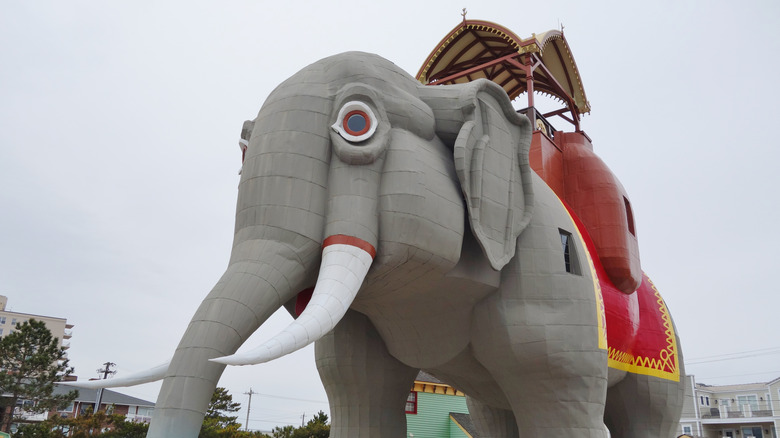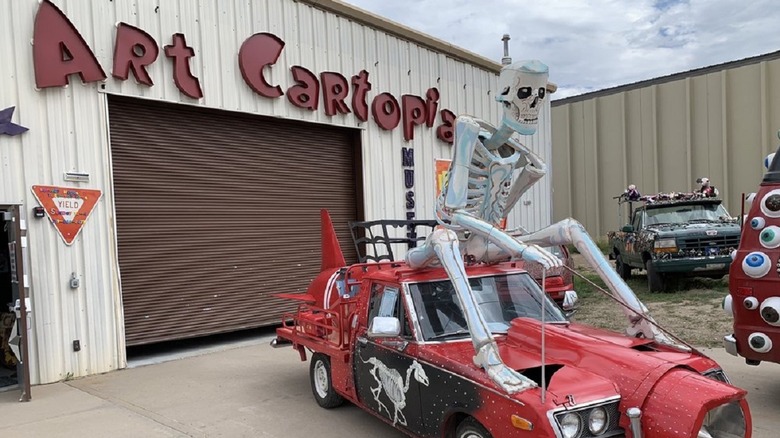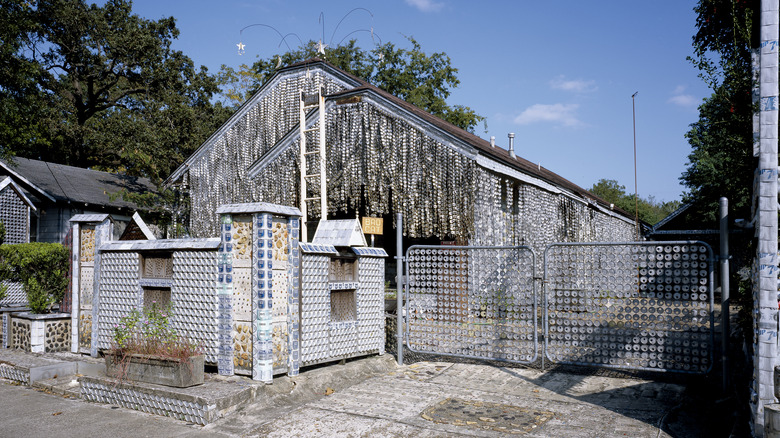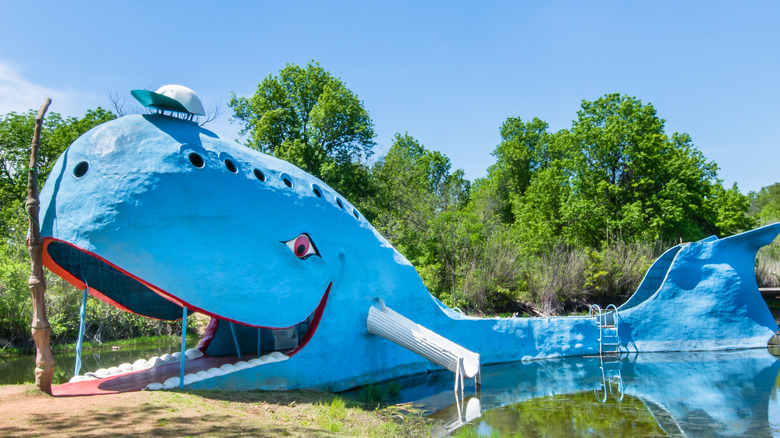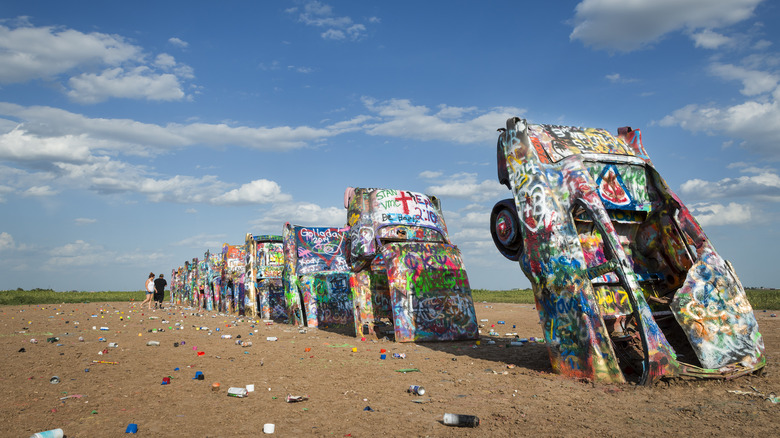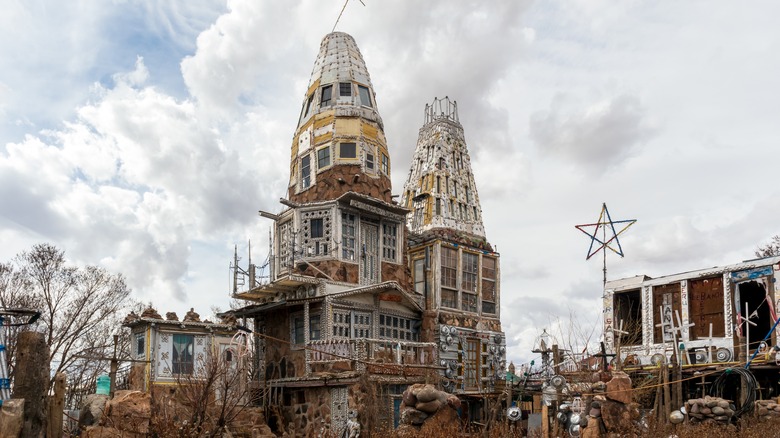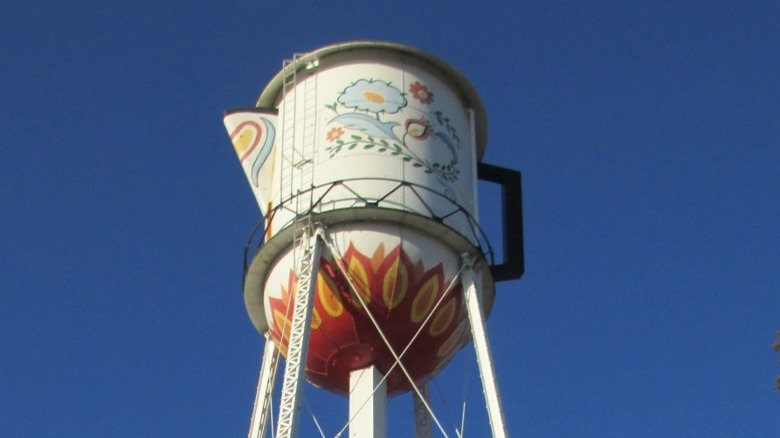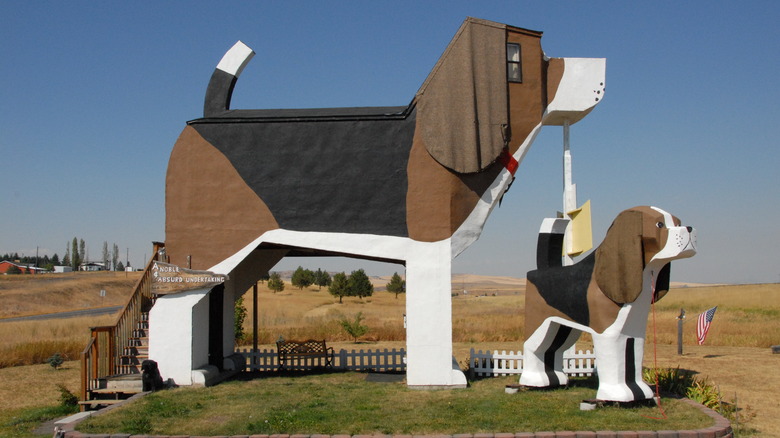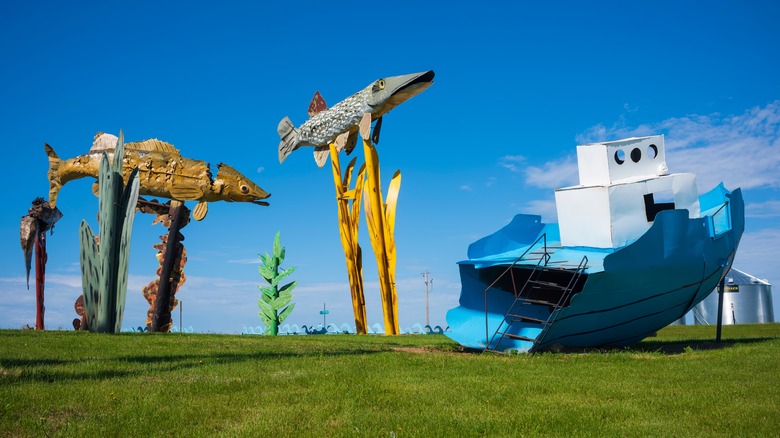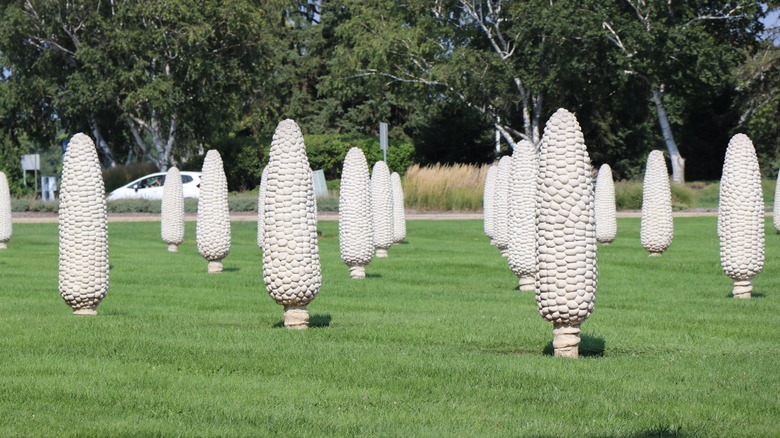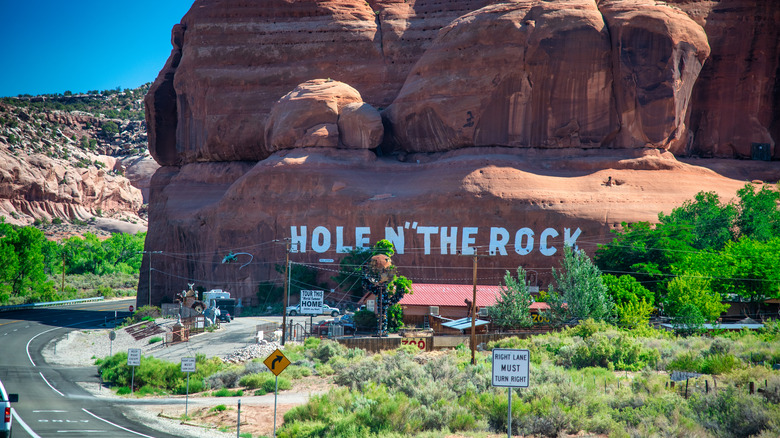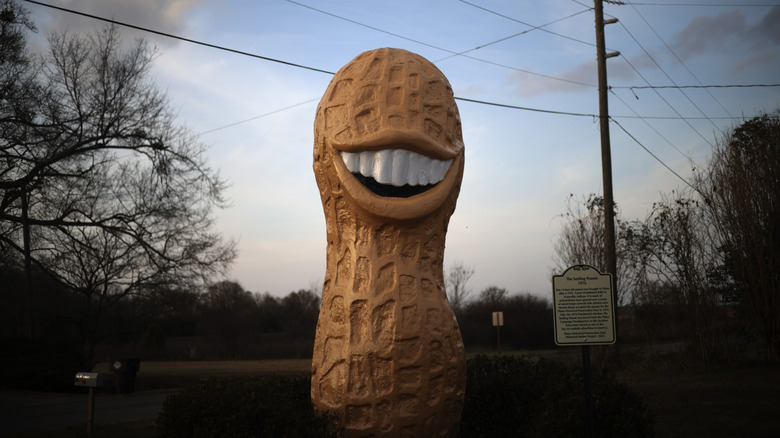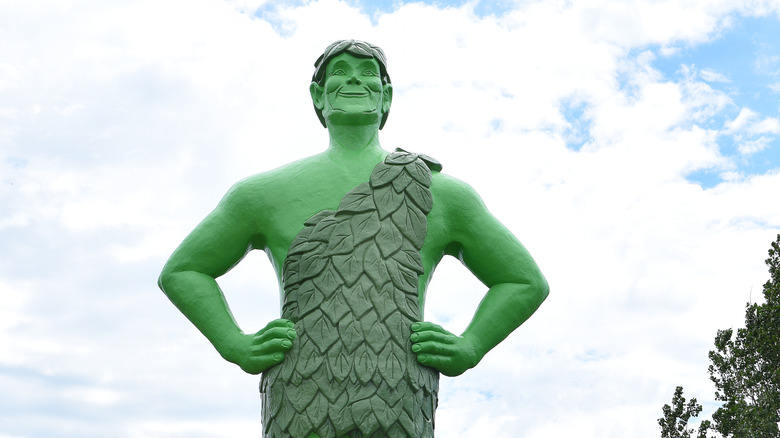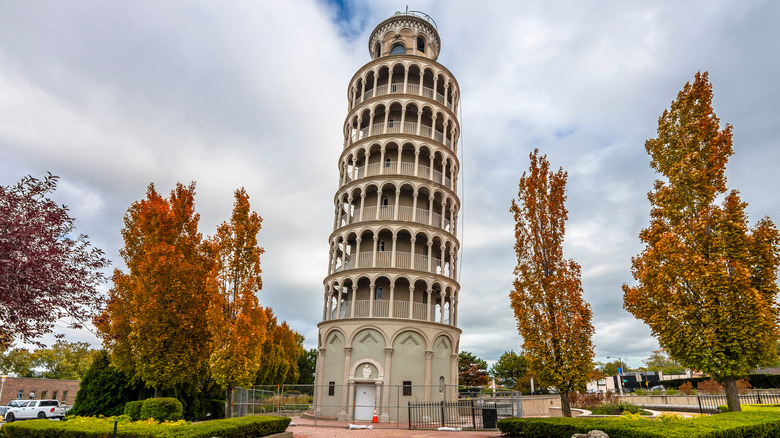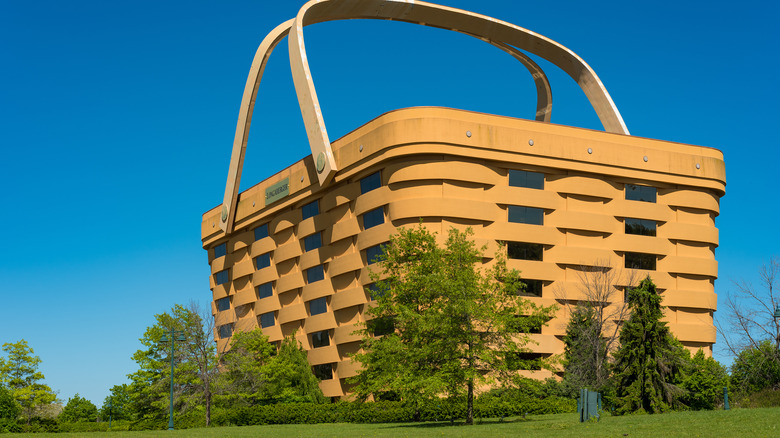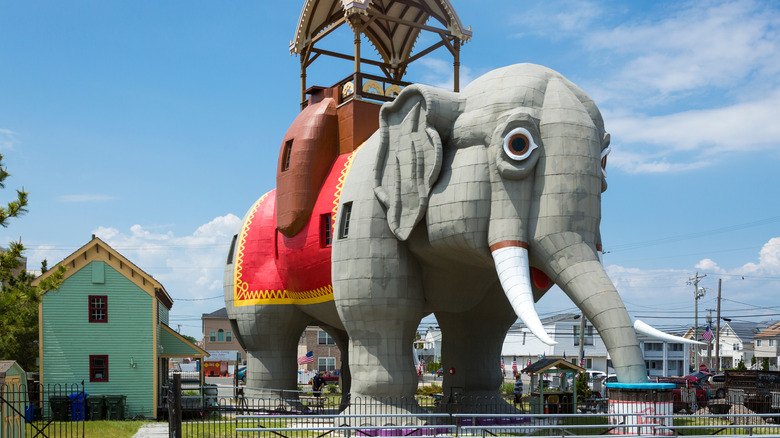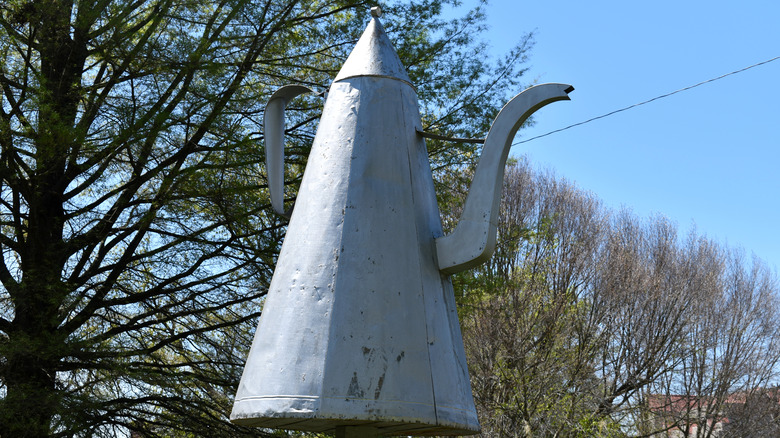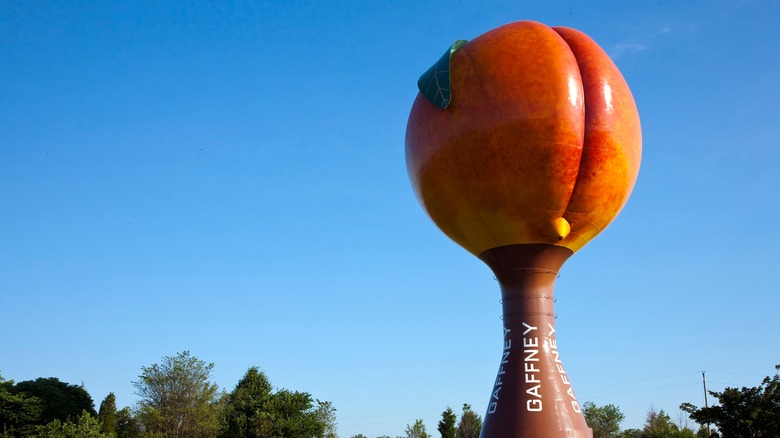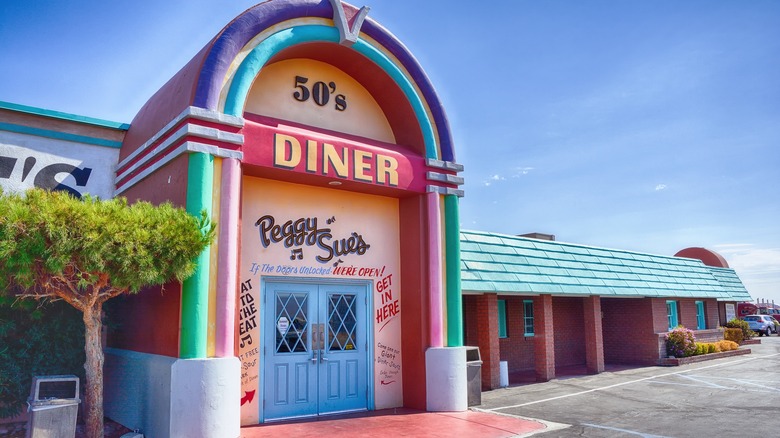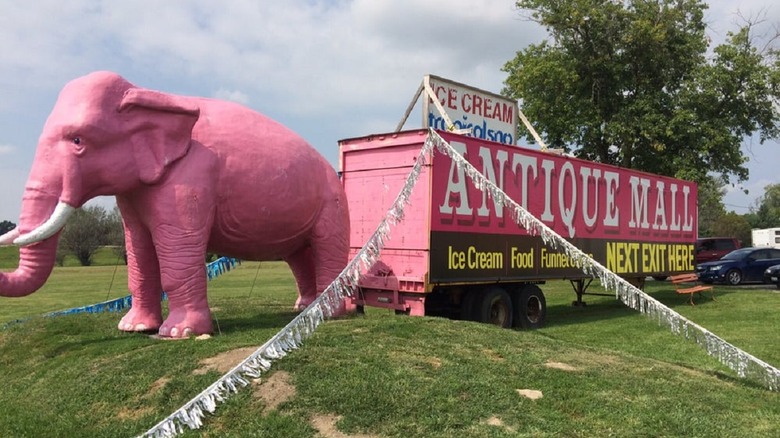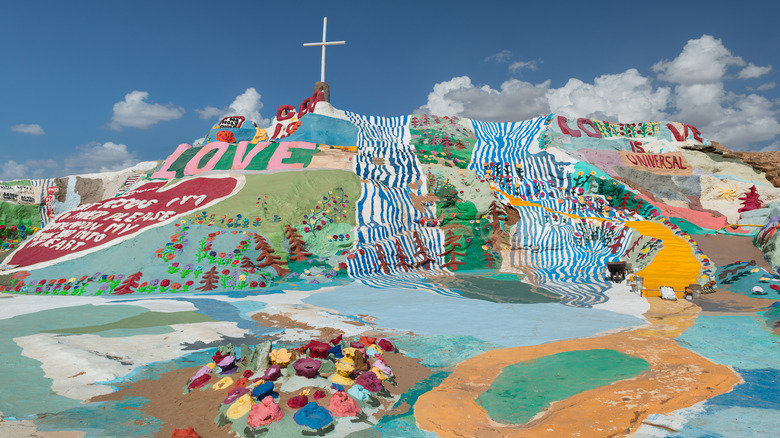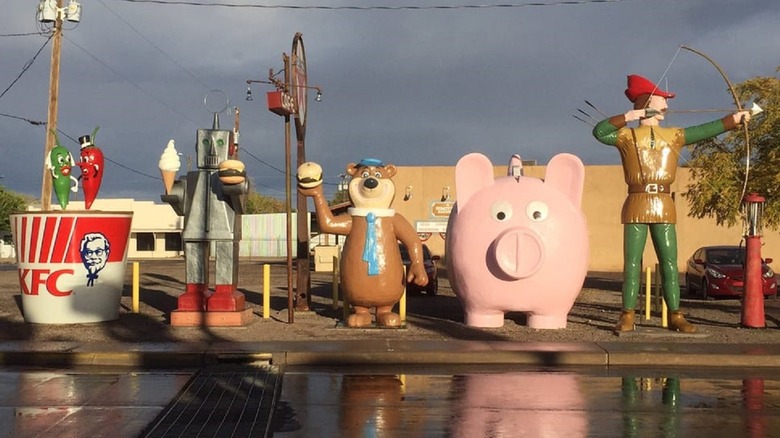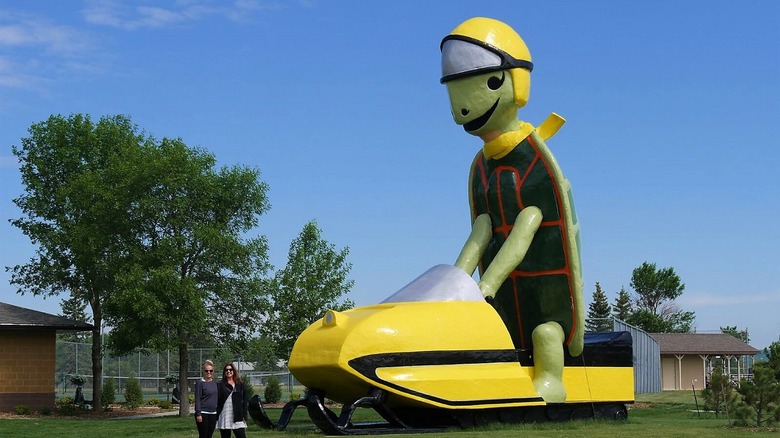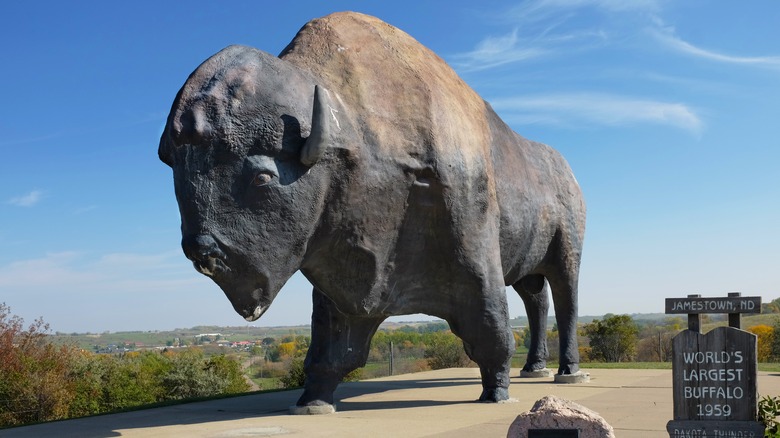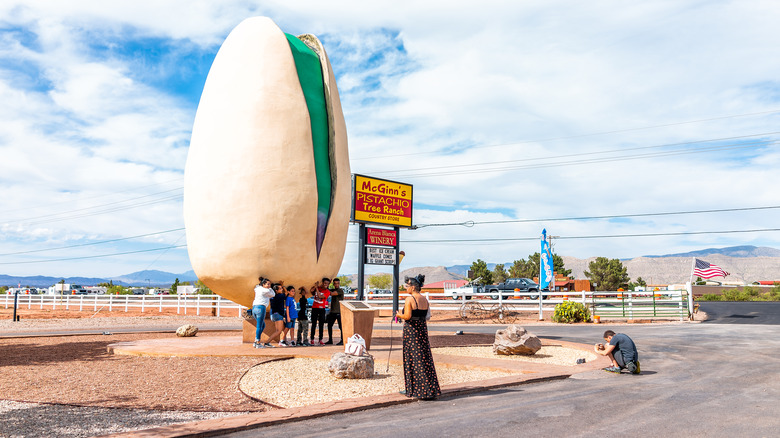25 Weird Roadside Attractions You Need To See To Believe
Road-tripping across America is a feat every traveler should try. Whether you're traveling with kids or on your own, going with a group of good friends, or traveling with a significant other, there are roadside attractions you'd enjoy. Many of these bizarre statues and strange museums are hidden inside the highway routes of landlocked states and underrated small towns. But others are hidden in plain sight in big cities, large icons that only the locals really know about.
Rest stops don't have to be boring. Before you travel to a new city or try your luck at traversing distant highways, get acquainted with some of the nation's greatest roadside attractions you'll need to see to believe.
Art Cartopia Museum (Trinidad, Colorado)
Self-described as "the greatest art car museum on earth," the Art Cartopia Museum is well worth a pit stop. Off the side of I-25, you can catch a glimpse of a skeleton riding a jet plane, a Volkswagen covered in googly eyes, and a school bus decked out to look like a dragon. These cars, and many more, have been transformed by "cartists" into individual works of art and are on display year-round. On not-windy days, a gigantic inflatable King Kong holds a car over his head and greets oncoming traffic.
Admission is free to see the huge showroom of wacky vehicles, so why not take a gander on a break from a long drive?
Beer Can House (Houston, Texas)
John Milkovisch created the Beer Can House over a span of 20 years using over 50,000 cans of beer. Bored after retirement and "sick of mowing the grass," Milkovisch could have traveled to a relaxing post-retirement destination, but instead began laying thousands of marbles, rocks, and pieces of metal into the concrete and redwood around his house in 1968. He had soon covered his entire front and backyard and began working on coating the actual structure of his house with recyclables. Specifically, Milkovisch coated his walls with aluminum beer cans.
The house is now considered a folk art icon and is complete with hanging garlands of cans Milkovisch crushed — in more ways than one. The house is mostly made from beers he consumed himself, though his wife and friends did occasionally help out. The cans were hardly from the best-tasting beers in the country. Milkovisch's favorite beer was always "whatever's on special."
The Blue Whale (Catoosa, Oklahoma)
Zoo worker Hugh Davis built the Blue Whale as an anniversary gift for his wife in 1972. He envisioned the friendly-looking whale as a place where children could swim and play by the lake. In addition to running two petting zoos (both of which he also built), Davis maintained the huge structure and kept a concession stand nearby until he passed away in 1980. Blue suffered wear and tear from neglect and weather until 1988 when Davis's son took to repairing the friendly sea creature. Blue has sat smiling by the water in mint condition ever since.
Add this to your list of must-stop attractions along Route 66.
Cabazon Dinosaurs (Cabazon, California)
The Cabazon Dinosaurs have long been one of the strangest tourist attractions in the U.S. These two huge statues of dinosaurs (named Dinny and Mr. Rex) are tall enough to be visible from Interstate 10. Dinny and Mr. Rex have been standing since 1975 and 1986, respectively, and have been bringing joy to passersby ever since. Claude Bell, a local sculptor, created the dinosaurs as a way to attract people driving by on the highway to his restaurant. Bell's family later sold the property (dinosaurs included).
Dinny has a gift shop and museum at his base that's used to promote the creationist theory that dinosaurs walked the Earth at the same time as Adam and Eve 6,000 years ago. But the attraction has nonreligious fun for visitors to enjoy. There's ice cream available at the Wafflesaurus Rex Ice Cream Truck, and anyone can climb up through Mr. Rex and sit inside his humongous mouth.
Cadillac Ranch (Amarillo, Texas)
In the middle of the desert near Amarillo, Texas, 10 Cadillacs are nose-down in the sand, half-buried, lined up single-file, and covered in graffiti. This art installation is from the minds of Chip Lord, Hudson Marquez, and Doug Michels, all of whom were members of the experimental art group Ant Farm. The trio chose to pitch their idea to eccentric millionaire Stanley Marsh 3 (who opted against using the Roman numeral III in his name to avoid looking pretentious) for funding, and he complied. In 1997, the installation was built. Since then, the cars have been repainted a number of times for various reasons, but were re-graffitied to their original colors in 2012.
You can drive by and stop for a photo off the south side of Interstate 40, around 10 miles southwest of Amarillo.
Cano's Castle (Antonito, Colorado)
Companies have tried to reduce metal waste by making their beer cans recyclable, but one man had another idea. In the middle of an otherwise average Colorado neighborhood lies a silver tower made from scrap aluminum and other trash. Donald Espinoza (who now only goes by "Cano") created the folk art installation using primarily beer cans, but also included other objects made with reflective metal: hub caps, bicycle reflectors, grills, window casements, and more. The bright sun makes his castle blinding to look at when the skies are clear, and the structure towers above the other houses nearby.
Though his house is flashy, Cano is something of a loner. He prides himself on living off the grid and avoids talking to strangers. When asked about his castle, Cano tells people that "God built it" and that his inspirations for its construction were "Vitamin Mary Jane" and Jesus. He doesn't mind spectators viewing his castle for free, though he has been known to request a donation from those who want to speak with him.
Coffee Pot Water Tower (Stanton, Iowa)
Water towers are often deemed landmarks of small, rural towns, but in Stanton, Iowa, one water tower is especially beloved. Painted with a traditional Swedish design, the coffee pot-shaped water tower is the largest Swedish coffee pot in the world and a local symbol of good hospitality. Though the water tower did provide water to the town when it was built in 1914, the tower is no longer functional. It was dismantled and brought down from its tall post in 2015, and now sits reassembled and preserved on the grounds of the town's Swedish Heritage and Cultural Center.
The coffee pot held 40,000 gallons of water at a time — the equivalent of 640,000 cups of coffee. You'd have to drink more than 17 cups of coffee every single day for 100 years to come close to emptying the volume of that tank.
Dog Bark Park Inn (Cottonwood, Idaho)
The Dog Bark Park Inn might be one of the coolest places in America to stay the night. Created by self-taught chainsaw artist Frances Conklin and her husband Dennis J. Sullivan, the Dog Bark Park Inn is shaped like a giant beagle named Sweet Willy. Sweet Willy is 30 feet tall, has a much smaller friend and fellow dog carving named Toby, and is a fully functioning bed and breakfast. Inside Willy's belly, there's a single room with a bathroom and a loft.
Conklin and Sullivan specialize in folk art wooden carvings of canines, but Sweet Willy is their pride and joy. They've decked him out with free Wi-Fi, a clock radio, a mini-fridge, hair dryer, books, games, and puzzles. Guests are also welcome to stay for breakfast and (of course) pets are welcome!
Enchanted Highway (Regent, North Dakota)
The Enchanted Highway is a collection of the largest scrap metal sculptures in the world dispersed over 32 miles of a two-lane highway in North Dakota. The sculptures, created and maintained by Gary Greff, are intended to increase traffic in the area and fight the growing disinterest in small-town America. Greff had zero artistic experience prior to creating the sculptures, but the hidden gems have succeeded in saving the town of Regent from extinction. Greff plans to continue building more along the same road.
Every statue has a meaning related to North Dakota's history. Teddy Roosevelt stars in one statue, for example, while others feature local wildlife such as grasshoppers and deer. Greff later opened a motel called the Enchanted Castle for visiting guests to stay, and has plans in the works to open a top RV resort, drive-in theater, and quaint cafe.
Field of Corn (Dublin, Ohio)
Ohio has plenty of corn, but this is no ordinary cornfield. The Field of Corn in Dublin, Ohio, is one of the oddest, most famous attractions in the Midwest. The artistic installation features 109 person-sized sculptures of gray ears of corn. Each one is 6 feet 3 inches tall, and all are set in orderly rows across the large field. The piece is meant to symbolize the community's longstanding legacy of farming and to celebrate the culture of the town — but the sentiment may have been a tad too corny, because it became more of a joke to residents than a serious homage to agriculture.
Tax dollars were being spent on inedible giant food, rather than actual food grown in the ground. The field was once used to farm actual corn by Sam Frantz, who helped to pioneer the use of hybridized corn. No matter the controversy, visitors still come from all over to visit the installation and learn kernels of the town's history.
Hole N the Rock (Moab, Utah)
With a name like Hole N" the Rock, you might not think this landmark was really anything special. But when you see the giant lettering painted on the side of a rock off of Highway 191 in Moab, Utah, don't drive by without making a pit stop.
The incorrectly punctuated signage points to a 5,000-square-foot cavern carved into the rock face by local couple Albert and Gladys Christensen in the 1940s. They blasted open the hole with dynamite to use it as their home, working on creating a large enough space for 12 years. Once it was finished, they moved in with their family and opened a diner they hoped would earn them some money. The establishment brought a whole new meaning to the idea of a "hole-in-the-wall" diner, and was quite a success. Albert died just five years after it was finished, in 1957. But his wife lived in the hole and ran the diner until 1970, when she died. Both Albert and Gladys are buried on the property.
Now the cavern functions as a roadside attraction complete with guided tours of the old home, a rock and cactus garden, Native American pottery, a petting zoo, and an ice cream shop.
Jimmy Carter Smiling Peanut (Plains, Georgia)
The Democratic Party commissioned the Jimmy Carter Smiling Peanut in Georgia as a publicity stunt to win the hearts of voters — and it worked. The 13-foot-tall attraction helped Jimmy Carter beat Gerald Ford in Plains and every other voting district in Georgia in 1976. The statue still stands tall bearing Carter's trademark toothy grin. Tragically, the second-largest peanut in the world was caught in a fender bender in 2000 and had to be moved from the local train depot to the Davis E-Z Shop in Plains. But it still stands intact today.
There is just one mystery of this giant peanut: There's a small hole in his frame and no one is sure how it got there. Some theories say that the Secret Service carved it there during the election so they wouldn't have to crack open his shell to check the interior for bombs.
Jolly Green Giant (Blue Earth, Minnesota)
An 8,000-pound, 55.5-foot-tall fiberglass rendition of the Jolly Green Giant towers over the terrain of Blue Earth, Minnesota, reminding residents to make healthy choices. You might think that the food company commissioned, or at least had something to do with, what looks like a giant advertisement — but Green Giant had nothing to do with it. Rather, a radio station host named Paul Hedberg took the initiative to fund and create it, thinking that it might attract more visitors to his small town. Blue Earth used to be home to a factory that canned Green Giant vegetables (though it's no longer used for that purpose), so Hedberg used to give canned vegetables to guests of his show.
The statue ended up being farther from the highway than Hedberg expected, but is still considered a success. As a result of the Jolly Green Giant, the town created "The Giant Museum Featuring Jolly Green Giant Memorabilia" and hosts an annual "Giant Days" festival. The town loves the statue — in winter, the Blue Earth Fire Department gives the green guy a bright red scarf to keep warm.
Leaning Tower of Niles (Niles, Illinois)
Just 15 minutes outside the Chicago O'Hare airport in Pisa's sister city, Niles, Illinois, there's a half-sized replica of Italy's Leaning Tower of Pisa. The tower was built in 1934 by Robert Ilg, intended as a place to store water for a nearby public pool. Ilg also had a special admiration for Galileo, who was said to have used the original leaning tower to help prove theories about gravity.
Today, the on-site water fountains serve no purpose other than aesthetics, but the tower remains an attraction for visitors. It's also 10 minutes from the world's first-ever McDonald's — a somewhat different food scene than you'd find in Pisa, Italy.
Longaberger Basket Headquarters (Dresden, Ohio)
The Longaberger Company was a large manufacturer that sold baskets and other housewares. Once a billion-dollar company, their headquarters was based in a building that looked like a gigantic maple wood basket. But running a business is no picnic. The Longaberger Company went out of business in 2018, leaving the wacky building behind. The seven-story building can still be seen from Main Street in Dresden, Ohio.
Lucy the Elephant (Margate City, New Jersey)
On your way to Atlantic City, you might want to take a slight detour to catch a glimpse of Lucy. Lucy the Elephant is a six-story architectural display and the oldest surviving roadside attraction in America, having been around since 1881. She's listed on the National Register of Historic Places and draws thousands of tourists each year. Visitors can stop to take a guided tour through Lucy's insides (she brags she's "the only elephant in the world you can walk through and come out alive") and see a 360-degree view of the surrounding landscape from the howdah on her back.
Lucy has quite the history (11 chapters of it on her website, in fact), but here's the long and short of it: She was built for the sole purpose of drawing publicity and was modeled after the real "largest elephant on Earth" at P.T. Barnum's Greatest Show on Earth. Lucy weighs around 90 tons, over 14 times the weight of the real elephant, Jumbo.
Old Salem Coffee Pot (Winston-Salem, North Carolina)
On a side street in Winston-Salem, North Carolina, you'll find a 7-foot-tall tin coffee pot suspended beside the road. The coffee pot is one of the area's oldest landmarks. It was built in 1858 by two tinsmiths, Julius and Samuel Mickey, who intended it to promote their tin shop.
Since then, there have been a number of legends circulating about the coffee pot, none of which are likely true. Tour guides tell visitors that the town's founders used to brew and drink coffee from the large pot on Easter Sunday. Others tell stories of a Union soldier who hid in the kettle during the Civil War. One tale speaks of a young boy who used to climb into the pot to light a fire and make steam come out of its spout. No details to support any of these stories have been found. An anecdote that did prove true was that local children used the coffee pot to pull off an annual prank every Halloween. The kettle was knocked down from its post, only to be hoisted again year after year. One year, the joke was taken too far when a group of teenagers lit a firecracker inside and burst open the entire structure. The teens' families were forced to pay to repair the kettle, and it has not been knocked down since.
Peachoid (Gaffney, South Carolina)
Nicknamed the "Peach Capital of South Carolina," Gaffney is home to a water tower that's shaped like a giant peach. The peach is 135 feet tall and can contain up to 1 million gallons of water. According to the South Carolina Department of Parks, Recreation, and Tourism, this is the most-photographed water tower in the United States, though perhaps not for the reason the town intended. It was anticipated that the tower would draw a crowd, but they never expected to develop a history quite so juicy.
Partially the fault of the peach emoji, the giant peach reminded people less of James from the innocent children's novel and more of a certain body part. The tower quickly became the butt of many jokes, and rumor has it that, blaming the danger of rubbernecking injuries from passing cars on Interstate 85, civic authorities ordered it be repainted in the early '90s.
Peggy Sue's '50s Diner & Diner-Saur Park (Yermo, California)
A trip to Peggy Sue's is a trip back in time — to both the 1950's and the prehistoric age. On the side of a highway in the middle of the Mojave Desert, travelers will find a '50s-style diner (complete with a '50s-style menu) with a giant jukebox for an entrance.
Peggy opened the establishment with her husband Chip in 1981. Peggy worked as an actress and Chip was a worker at Knott's Berry Farm, one of the best theme parks in America. The interior of the diner is filled with the couple's TV and movie memorabilia, including a life-size statue of Betty Boop. Waitresses are decked out in vintage-style pink-and-teal uniforms. There's also a vintage ice cream counter and a backyard "Diner-Saur Park." Out back, visitors can meander through 10-foot-tall metal statues of dinosaurs and a massive King Kong.
Pink Elephant Antique Mall (Livingston, Illinois)
Interstate 55 is home to a few odd attractions, but this one is larger than life. The Pink Elephant Antique Mall is surrounded by large statues of everything from Alvin and the Chipmunks to a "muffler man" (one of those colossal fiberglass statues of a man holding something that dot American roadways from coast to coast) wearing a Harley-Davidson shirt. From the highway, it's impossible to miss — the entrance is guarded by a giant pink elephant.
Inside the building itself, there's a bustling flea market filled with trinkets and homemade items for sale. A newly opened Route 66-themed nostalgic diner serves greasy, fried appetizers and other American foods. Outside, an ice cream cone-shaped shop called "Twistee Treat" sells frozen desserts including soft serve, sundaes, and milkshakes.
Salvation Mountain (Niland, California)
Salvation Mountain is an immersive art installation on a hillside in Niland, California. Constructed of adobe, straw, and thousands of gallons of paint, the visionary environment was created by local resident Leonard Knight as a religious tribute. On the side of the hill, Knight painted mural after mural depicting Bible verses and Christian symbols and sayings.
Instagram influencers travel from far and wide to take photos in front of the massive piece, which must be constantly repaired and maintained due to the harsh weather of its surrounding environment. It requires so much paint to complete and maintain that the surrounding soils have absorbed high levels of toxic lead. After discovering the contamination in 1994, repairs to the site switched to lead-free paint. Visitors and others who support the installation donate lead-free paint, and volunteers often gather to work on touching up damaged spots on the site.
Sparky's Burgers, BBQ & Espresso (Hatch, New Mexico)
If you ever find yourself in Hatch, New Mexico, and want to stop for a bite, consider stopping at Sparky's. A novelty restaurant specializing in burgers, barbecue, and espresso, they'll satisfy your greasy food and caffeine cravings. Inside, many of the menu items find creative ways to incorporate Hatch chile peppers (the town's namesake) into dishes like burgers, fries, milkshakes and other classic diner fare. But the best part about Sparky's is the decor.
Out front, a robot alien named Sparky greets hungry customers, as does the Statue of Liberty, Ronald McDonald, and a 30-foot-tall Uncle Sam. On the roof, the A&W family lines up with burgers. Across the street, you'll see huge statues of Robin Hood, Hamm from "Toy Story," Yogi Bear, a robot, a bucket of KFC, and a bright-green alien.
Tommy the Turtle (Bottineau, North Dakota)
Tommy the Turtle, a landmark in Bottineau, North Dakota, is the largest turtle in the world. He's meant to pay tribute to and symbolize the nearby area that used to be a gateway to the Turtle Mountains. The mountains themselves are long gone, said to have been destroyed by the last ice age.
The snowmobile-driving reptile towers more than 30 feet over the side of country roads near the Canadian border. He weighs 3 tons and sits atop a 34-foot-long snowmobile that visitors can ascend into to stand on a platform as his passenger. Surrounding a grinning, helmet-wearing Tommy is a park — Tommy Park, also named after him — where children often come to play.
World's Largest Buffalo (Jamestown, North Dakota)
Buffalo are already pretty large (each animal weighs approximately 1,000 to 2,000 pounds), but this one outweighs them all. The World's Largest Buffalo, a giant statue in Jamestown, North Dakota, is 26 feet tall and 46 feet long, and it clocks in at a massive 60 tons. That's the equivalent of the weight of 60 large buffalo.
The idea for the monument arose in 1958, when the first stretch of highway was built near Jamestown. By building something attention-worthy near I-94, residents hoped to draw in more visitors to their small town. Elmer P. Peterson, an art teacher at the local college, was hired to make something big and impossible to ignore, and the World's Largest Buffalo was born. He's massive, made of metal and cement, and anatomically correct. After the buffalo's 50th birthday, Jamestown held a contest to come up with a name for their beloved monument. In 2010, he was officially christened "Dakota Thunder."
World's Largest Pistachio (Alamogordo, New Mexico)
You'll know you've arrived at PistachioLand in Alamogordo, New Mexico, because outside the building is a huge 30-foot-tall pistachio. The monument is more than just an advertisement for the local nut business. Tim McGinn, whose father Tom founded McGinn's Pistachio Tree Ranch, commissioned the statue to commemorate the elder McGinn after he passed away. It might seem a little nutty to create a roadside spectacle to remember your father by, but Tom was said to have loved roadside attractions while he was still alive. "Tom dreamed big, expected big, and accomplished big things," reads the bronze plaque placed outside. "He would have said the monument is not big enough!"
The icon is held up on a pole and anchored in 9 feet of concrete. But don't let this gigantic nut be your only draw to this attraction. While you're at PistachioLand, pick up some delightful pistachio-flavored treats such as chili-chocolate pistachio brittle, barbecue roasted pistachios, and homemade pistachio milkshakes.
